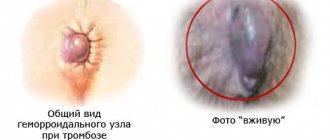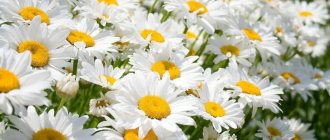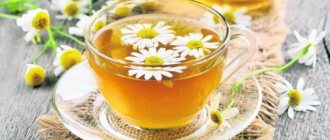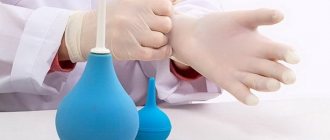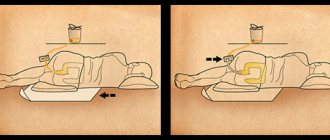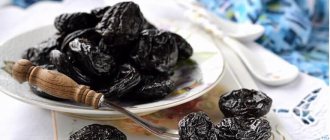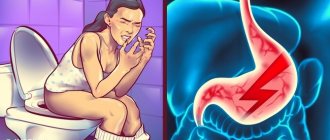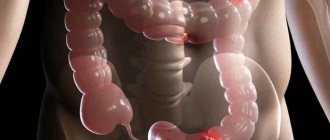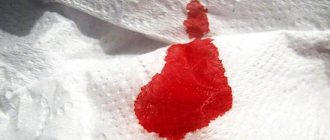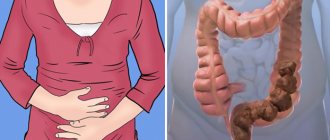Contraindications
Despite the simplicity of the action, mini enemas are not recommended for:
- Colic and acute abdominal pain;
- The presence of pronounced, painful wounds and cracks in the rectal area;
- Temperature above 37 degrees;
- Cardiovascular pathologies;
- Bleeding;
- Tumors in the rectum;
- Recent abdominal surgeries are considered a temporary contraindication;
- Self-prepared solutions should not be used during pregnancy or before reaching 5 years of age;
- It is required to use microenemas for constipation with special caution for older people if they have high blood pressure.
For chronic gastrointestinal diseases, it is recommended to consult a doctor before undergoing the procedure.
Efficacy for constipation and other conditions
The decision to administer a microenema is made by the doctor, based on the general condition of the patient. Indications for performing an enema for constipation are associated complications:
- when feces move through the intestines, pain is felt,
- bloating,
- formation of dry, compacted fecal accumulations,
- proctitis (hemorrhoids),
- prostatitis.
Ready-made medications effectively deal with problematic stools, have a healing effect, and help remove feces painlessly, helping to soften them.
The product works in the rectum without penetrating into other parts of the gastrointestinal tract. Disinfects and heals cracks, relieves inflammation.
Mini enemas are indispensable before going to the proctologist, for identifying diseases of the colon and rectum, for infectious diseases, and poisoning.
Kinds
Microclysters can be different in their purpose:
- Laxatives;
- Emollient;
- Cleansing;
- Emulsion;
- Medicinal. The basis is components with hemostatic, regenerating or anti-inflammatory properties.
In most cases, for constipation, the first 3 types of microenemas are used.
At home, it is possible to use both pharmacy and self-prepared solutions.
Oil microenemas
They are prescribed mainly for constipation - to cleanse the intestines. Use Vaseline, olive, sunflower or sea buckthorn oil. In addition to softening the rectal mucosa, the oil supplies the body with useful substances - vitamins and microelements, thereby achieving an overall healing effect.
Another feature is that oil microenemas are prescribed if classic cleansing enemas are prohibited. The gentle effect of heated oil is what is needed in the presence of injuries, ulcers and other lesions of the mucous membrane.
Indications
- Chronic constipation.
- Flatulence.
- Inflammatory processes in the colon.
- Preparation for surgery on the digestive system and the postoperative period.
- The period after childbirth.
Contraindications
- Bleeding from the gastrointestinal tract.
- Oncology or rectal prolapse.
- Ulcers of the large intestine and anus.
Pharmacy microenemas
Pharmacy mini enemas for constipation contain substances that relax the intestines. Their use is convenient - there is no need to dilute the solution or use a syringe, since the medication is placed in a package equipped with a tip.
Pharmacy microenemas have the following advantages:
- There is no need to fuss with the dosage. The packaging is intended for single use;
- The required dose is in a convenient package. Its contents do not need to be poured out, just unscrew the spout, after which you can use it;
- The plastic container does not require disinfection;
- Microclysters purchased at a pharmacy are not addictive.
Norgalax
Suitable for use in cases of acute constipation. It is not suitable for chronic forms, as it has a serious contraindication - it has a negative effect on the liver.
Active ingredients of the drug: glycerin solution, sodium docusate. Available in 10 gram dosage.
Cannot be used:
- Pregnant women;
- Nursing mothers;
- For children.
Microlax
It is considered the most popular microenema. Advantages of this tool:
- Convenience and ease of use;
- Speed of onset of action. Defecation occurs within 15 minutes;
- Can be used by any age category.
Active ingredients: sorbitol solution, sodium citrate, lauryl sulfoacetate.
There is a side effect - an allergic reaction to the components is possible.
Peidolax
While Microlax has a single package, Peidolax is available in two forms: for adults and children. The adult package contains 7.5 milliliters of glycerin solution.
For children, packaging with a smaller volume of medicine is offered. Indicated for use in children at least 2 years of age.
Normacol
Different dosages of the drug are offered. The maximum is 130 ml and is intended for adults. The drug in a dosage of 60 ml is offered for children.
The active substance is a hypertonic solution. The composition of the solution includes a combination of mono- and disodium phosphates.
The drug may cause bowel movements 15-20 minutes after use.
Contraindications for the drug include old age and diseases of the cardiovascular system.
It should also be noted that Normacol can cause diarrhea, which leads to dehydration. Therefore, it can be used only in case of acute constipation, if you need to quickly empty the intestines.
Features of the use of microenemas
The use of not all types of enemas for constipation is acceptable in children or the elderly, pregnant women or bedridden patients. Some formulations may be hazardous to the health of certain people.
The use of microenemas is permitted and has virtually no contraindications. They are easy to use; there is no need to prepare a solution or use a rubber bulb. The mini enema is designed for one-time use and has a built-in tip for easy administration.
For the elderly
With age, problems with bowel movements appear due to constipation. Traditional laxatives do not have the desired effect, irritate the intestinal walls, and are addictive. The situation with stagnant fecal accumulations can be corrected with mini-enemas designed to soften feces and promote excretion without causing inconvenience, eliminating problems. Microenemas for constipation for older people in combination with a proper diet speeds up treatment and normalizes the water balance in the intestines.
In bedridden patients, problems with bowel movements and constipation are added to the underlying disease. For regular cleansing, you will need a safe, mild laxative. A mini enema with a ready-made medicinal solution has these properties.
For pregnant
With the onset of pregnancy, women experience constipation and problems with bowel movements caused by changes in the body. Pharmacy enema is easy to use and can be given at any stage and during lactation. A fast-acting mini-enema normalizes the water balance in the intestines, softens feces and removes them out. It can be given to infants almost from birth.
The composition does not affect pregnant women; it works directly in the intestine, without being absorbed into the bloodstream.
You should not douche frequently; it is better to combine it with a diet containing laxative fruits and vegetables. The drug is prescribed only by a doctor.
Folk recipes
You can do softening, cleansing, laxative types of mini-enemas on your own. The basis for the solution can be pharmaceutical drugs, food and herbs. For pathologies of the rectum - fissures, hemorrhoids, you can choose a solution that will not only facilitate bowel movements, but also relieve inflammation and speed up healing.
Microenema - features of the procedure
Microclyster is the process of introducing a special drug or solution into the rectum in a minimal amount. The volume of injected fluid in most cases varies from 50 to 300 ml. A small amount of the medicinal solution used allows the patient to independently carry out the procedure by administering the liquid using a regular syringe.
You can administer a microenema yourself using a regular syringe.
Experts recommend enemas for various diseases accompanied by constipation. High efficiency and noticeable positive results are achieved only if the procedure is carried out correctly throughout the entire therapeutic course.
Microclysters are prescribed for pathologies accompanied by the following symptoms:
- various stages of hemorrhoids;
- increased bloating;
- formation of dense, hard feces;
- painful spasms in the intestinal area that occur during bowel movements.
Cleansing enemas
Microclysters with cleansing properties are used if constipation is accompanied by flatulence and pain when stool passes through the intestines. Such enemas include:
- Honey. The solution is prepared by adding a spoon of liquefied honey and lemon juice to 20 milliliters of boiled water. The solution can be used after thorough stirring;
- Coffee. The solution is prepared from 3 tablespoons of natural coffee, which must first be ground. The coffee powder is poured into a glass of distilled water, then placed on low heat for 5 minutes, then the power of the stove is increased and the solution is boiled for 10 minutes. The finished solution is filtered after cooling;
- Starch. The basis can be ordinary potato starch, which can be replaced with wheat, rice, or corn. Dilute 5 grams of dry starch with 0.5 cups of distilled water, then place the saucepan on the stove and gradually add half a glass of water to the solution while boiling slowly. The solution can be used after cooling.
The use of enemas in childhood
In children, cleansing, medicinal, and nutritional K are used. Cleansing K are used for constipation, poisoning, and before the administration of medicinal enemas and rentgenol. examination of the abdominal organs. Cleansing K. are prepared from boiled water t° 28-38°. For atonic constipation, the water temperature can be reduced to 20°. The amount of water depends on the age of the child (table).
For K., only a rubber tip is used (so as not to injure the intestinal mucosa), which is generously lubricated with petroleum jelly. For older children, you can use an Esmarch mug; For children under 5 years of age, rubber cylinders are used for K., which must be boiled before use. To fill the balloon, it is squeezed until the air is completely displaced, after which the tip is lowered into water and filled with water. Then lift the tip up and release the air until water appears. You need to put an oilcloth under the child and cover it with a sheet. The child is placed on his left side, holding the child's body with his left forearm, and with his left hand - the legs bent at the knees and pressed to the stomach. With the right hand, insert the tip into the rectum 3-5 cm (depending on the age of the child). The fluid should be injected slowly without much pressure.
If you use an Esmarch mug, then it is raised no higher than 60 cm. After removing the tip, you need to squeeze your buttocks for a few minutes to retain water to sufficiently soften the stool.
To enhance the laxative effect of K., you can add glycerin (1-2 teaspoons per 1 glass of water). Sometimes they use oil K. from vaseline or vegetable oil (30-50 ml per enema). Before use, vegetable oil should be boiled to remove fatty acids.
For intestinal paresis, which is often observed in infants, and for a number of diseases, hypertensive K. is given from a 10% sodium chloride solution (20-30 ml).
For coprostases, siphon water pumps are used with a total water consumption of no more than 1500 ml for children under 1 year of age, approx. 5 l for children aged 2-5 years and approx. 8 l for older children.
Medicinal K. is given to children according to the same indications as adults, after 15 minutes. after cleansing K. The temperature of the injected liquid should be close to the child’s body temperature. The liquid with the medicinal substance is administered in a small amount (no more than 15-50 ml) and slowly to avoid the urge to defecate. After administering the medicine, slowly remove the tip and leave for 10-15 minutes. squeeze the buttocks to prevent the fluid from coming back out. Medicines that can cause irritation of the intestinal mucosa are administered with the addition of warm brewed starch.
For infants with flatulence, chamomile is often used, which adsorbs gases and has a weak astringent effect on the intestinal mucosa (1-2 teaspoons of chamomile per 1 glass of boiling water, infused for 2-3 hours, and then filtered). For ulcerative enterocolitis, a mixture of sea buckthorn oil and rosehip oil is used (20-30 ml per enema). For enterobiasis, soda water is recommended at night (1/2 teaspoon of soda per 1 glass of water).
In pediatric practice, K. is widely used with analgesics (analgin, amidopyrine). Microenemas are also offered in the form of hermetically sealed rectal pipettes made of polyethylene with a dosed content of drugs in the form of emulsions, suspensions, liniments (amidopyrine, antipyrine, butadione, furazolidone).
Table. Recommended amounts of liquid for cleansing enemas in children of different ages
| Child's age | Amount of liquid administered, in ml |
| Newborns (up to 1 month) | 30 |
| 1-3 months | 60 |
| 3-6 months | 90 |
| 6-9 months | 120-150 |
| 9-12 months | 180 |
| 1-2 years | 200 |
| 2-5 years | 300 |
| 6-9 years | 400 |
| 10-14 years | 500 |
Laxatives
For mini-enemas for chronic constipation, it is recommended to use solutions with a laxative effect. Oils or saline solution are used as a base:
- Oil enemas should be prepared from almond, olive, peach or regular vegetable oil. You need 50-100 ml of oil, heated to a temperature of 40 degrees. The effect of the enema will begin after 8 hours;
- The saline solution is prepared from magnesium sulfate powder. To prepare, you need to take one spoon of dry powder and dilute it in a glass of boiled water. The solution is injected into the rectum after complete dissolution.
Folk remedies for microenemas
The use of folk remedies for microenemas for constipation can be a worthy alternative to medications. Such recipes are used at home; laxative solutions are prepared independently.
Medicinal plants and bee products are used to prepare laxatives, cleansers, and emollients. They not only help restore stool, but also relieve a person from bleeding, pain and inflammation from hemorrhoids. Home microenemas promote accelerated regeneration of the rectal mucosa.
Cleansing procedures
The action of a cleansing enema is aimed at removing hard, dense feces from the body. There are a huge number of recipes that can be used at home.
Coffee: 3 tablespoons of natural ground coffee should be poured into 250 ml of water, placed on low heat and simmered for 5 minutes. After this, you need to boil the liquid for another 10 minutes over high heat. Next, you need to strain the coffee, let it cool slightly and use it for the cleansing procedure.
Honey: in 1/3 of warm boiled water you need to dilute a spoonful of natural honey and the same amount of freshly squeezed lemon juice. When the honey is completely dissolved, the liquid is injected into the rectal cavity using a rubber syringe.
Potato starch: pour a spoonful of the product into a bowl with 100 ml of water, then place on low heat. The solution must be brought to a boil, stirring constantly and slowly adding another 100 ml of water. Microclysters with starch solution are carried out when the product has cooled to room temperature.
Means for laxative microenemas
To prepare homemade laxative solutions, various oils of plant origin are used that have pronounced laxative characteristics. It can be sunflower, olive, peach, castor, coconut or any other oil.
Method for preparing an oil solution - 50-90 ml of the plant product must be slightly heated in a water bath, and then used for microenemas. The laxative effect occurs 6-7 hours after the procedure, so it is best to perform it in the evening, before bedtime.
You can use another laxative recipe - dilute 3 tablespoons of vegetable oil in ½ glass of warm water and inject the prepared liquid into the rectal cavity.
An effective alternative to oil enemas is saline liquid, which you can easily prepare with your own hands. Magnesium sulfate in powder form is used for this purpose. You need to dilute a tablespoon of the drug in 250 ml of warm water, and then carry out a laxative procedure.
Milk for constipation
Whole milk, when introduced into the rectal cavity, has softening and thinning properties and promotes accelerated excretion of feces from the intestines. Heat 250 ml of milk over low heat, add 1-2 tablespoons of butter, stir thoroughly, cool and use for microenemas. To increase the effectiveness of treatment, you can add table salt to the liquid at the tip of a knife.
Medicinal herbs against constipation
Medicinal plants have anti-inflammatory, bactericidal, analgesic and wound-healing properties, due to which they are widely used to treat constipation and normalize stool.
The most commonly used medicinal herbs are:
- sage;
- sagebrush;
- chamomile color;
- oak bark;
- mint;
- yarrow.
To prepare a medicinal solution, pour a tablespoon of crushed raw material into 100-200 ml of hot water, then leave to infuse for half an hour, strain and use for enema.
Emollient
If dry feces are released due to constipation, a course of 2 or 3 procedures can be performed. The solution is prepared according to the following recipe:
- Heat one glass of whole milk.
- Add 20 grams of butter to hot milk.
- After dissolving the oil, wait until the milk cools to 40 degrees, then insert it into the rectum.
- After the enema, you need to lie quietly for 15 minutes.
Such microenemas are done at night, and course use helps to stabilize the intestinal microflora. To enhance the effect, you can add one pinch of salt. If you have a history of gallbladder disease, it is better to add a decoction of wormwood instead of salt, which improves bile secretion.
How to give an enema to a child
Irregular bowel movements in a newborn do not always indicate the development of constipation. This may be due to the body adapting to the new formula for feeding. Experts say that stool retention for four to five days in a breastfed baby is considered normal. This, on the contrary, indicates complete absorption of milk.
An enema does not eliminate the very cause of constipation in a baby
Stool retention is a symptom that may indicate the presence of serious pathologies. That is why before carrying out the procedure you need to consult a specialist. Constipation in children is often a consequence of poor nutrition, stressful situations, physical inactivity, and allergic reactions. From this we can conclude that an enema does not cure constipation, it does not eliminate the very cause of this phenomenon, but only alleviates the condition.
To combat constipation, children can be prescribed the following types of enemas:
- cleansing. Use ordinary warm boiled water;
- medicinal. The warm solution is administered half an hour after the cleansing enema;
- siphon tests are carried out in case of severe poisoning and under the guidance of a specialist;
- oil Heated hemp, vaseline or sunflower oil is used.
Up to six months of life, the maximum amount of liquid that can be injected into the rectum is 60 ml. For children over one year of age, the norm is 150–200 ml. This indicator is also affected by weight, height, and severity of constipation. Therefore, you should definitely consult your doctor about the type of solution and its volume. In general, it is better for children under three years of age to cleanse the intestinal tract under the supervision of a specialist.
Important! The child should lie on his back or left side.
First of all, wash your hands with soap. Before cleansing the intestines, the pear must be doused with boiling water both inside and out. You should fill it with liquid and press to remove any remaining air. Don't forget to lubricate the pear with Vaseline oil. The liquid should be released from the syringe gradually, in slow bursts. The child should not feel any pain.
At the end, squeeze the baby’s buttocks with your hand for a few minutes so that the injected liquid does not immediately spill out. Next, massage your tummy clockwise. For deeper penetration of the liquid, place the child on his right side. Specialists can also prescribe special solutions, for example, chamomile, soap, soda, and saline.
In childhood, glycerin enemas are also allowed. To carry them out, you can use either a glycerin solution or pure glycerin. The technique helps stimulate intestinal motility. To carry out cleaning, you need to take a syringe based on the age of the child.
Cold and hot solutions are not used in the treatment of children. This can cause spasm of intestinal smooth muscles and discomfort. Abuse of enemas can lead to impaired intestinal motility, leaching of beneficial bacteria, weakening of the immune system, and a shift in acid-base balance.
During enema cleansing, the child should not feel any pain.
Herbal decoctions
Chamomile flowers, yarrow, sage, mint, and oak bark are most often used as a base. To prepare a glass of solution, you need to brew a spoonful of dry herbs with boiling water, then leave and strain.
Carrying out the microenema procedure on your own requires caution and compliance with all rules. This will not only prevent the occurrence of undesirable consequences, but will also increase the effectiveness of constipation treatment.
Contraindications to microenemas
Treatment of constipation with therapeutic microenemas is not recommended in the following cases:
- diseases of the heart and blood vessels;
- internal bleeding;
- increased body temperature;
- sharp painful spasms in the abdominal area;
- benign or malignant neoplasms.
Relative contraindications include sudden changes in blood pressure, acute or chronic diseases of the gastrointestinal system, as well as all trimesters of pregnancy. This means that microenemas are allowed, but only after prior consultation with your doctor.
Source
Rules for setting microenemas
At home, a mini enema is done using a rubber syringe of sufficient volume or using a Janet syringe, which requires the selection of a special tip. For children, it is safer to do mini-enemas with a small syringe with a soft tip. When carrying out the procedure, the following rules must be observed:
- The Janet syringe and syringe must first be boiled in water for at least five minutes;
- The solution should have a temperature of 37 or 38 degrees; for oil enemas, a 40-degree solution can be administered;
- It is necessary to lie on your left side immediately before the procedure, since this position promotes improved distribution of water in the intestines;
- The tip must be inserted using rotational movements;
- The tip is pre-lubricated with vegetable oil or petroleum jelly;
- The medicinal solution is poured in gradually. If a syringe is used, the liquid should be injected in spurts. If a syringe is used, after administering a solution with a volume of 20-30 ml, pause for a few seconds;
- After the enema, it is recommended to lie on your stomach for at least a quarter of an hour.
- Mini enemas, which have a softening and cleansing effect, are done after breakfast. Oil - in the evening.
It is also necessary to remember that the course use of mini enemas should be prescribed by the attending physician. Constant enemas can lead to aggravation of the problem, since restoring intestinal function requires a systematic approach.
Characteristics
Such an effective method of combating constipation as a microenema has an additional therapeutic effect on the patient’s intestines, stimulates peristalsis, and relieves pain.
You can buy it at the pharmacy, or make it yourself using a syringe or bulb with a volume of no more than 100 ml. and auxiliary components for the solution.
Mini enema differs from its larger “brothers”:
- The volume of the injected solution is from 4 to 100 ml.
- The concentration of medicinal substances is greater in microenemas.
- The quick-acting result is that after 5-15 minutes the urge to defecate appears.
- It acts directly in the intestines without affecting other internal organs.
The use of microenemas for pregnant women is contraindicated, with the exception of preparations with glycerol. Use with extreme caution and as prescribed by a specialist for elderly people, hypertensive patients, and children under three years of age.
You should refrain from microenemas in case of recent surgery, the presence of peptic ulcers in the intestines, malignant neoplasms, or at elevated body temperature.
Video:
Small enemas with chamomile
This remedy makes it possible to eliminate inflammatory processes or at least reduce them; chamomile can also act as a disinfectant for the intestines for various types of diseases. It is best to use such small types of enema in the evening, right before bed. To prepare the product, take three full spoons of dried chamomile flowers, pour them with 200 milliliters of boiling water, then heat the resulting composition in a water bath for about fifteen minutes, it is important to constantly stir this product.
As soon as the allotted time has expired, you need to take this decoction and cool it to a suitable temperature; this product must be filtered through cheesecloth several times. If the liquid has evaporated greatly, then enough liquid is added to the solution to make exactly two hundred milliliters of the composition. For an enema, only fifty milliliters of this decoction is used, since a larger amount can lead to unpleasant consequences.
You can also use more modern drugs in the form of microenemas to cleanse the intestines; in this case, the process of preparing for this procedure will be described in detail in the instructions for use of such a drug. Many doctors say that it is better to use modern laxatives in the form of such enemas, since they contain disinfecting and mild laxative components. But making homemade compositions is not always safe, firstly, they have their own contraindications, and secondly, they can certainly cause some complications.
Non-drug therapy for constipation
First of all, it is worth emphasizing the importance of diet. Doctors recommend eating foods that contain a sufficient amount of fiber: vegetables and fruits (boiled, baked or fresh). You should also eat fermented milk products, lean fish and meat, rye bread, dried fruits, and whole grain cereals. It is advisable to cook food in portions and not chop it. You need to eat at least 4 times a day in small portions. The temperature of food and drinks should be 15–60 °C. You need to drink at least 1.5 liters of water per day.
In addition to following a diet, you should maintain physical activity. It is recommended to walk outdoors for at least 30 minutes every evening. In normal health, you can perform special gymnastics and also go to the pool. If the above recommendations do not help solve the problem of constipation, the doctor will prescribe medications that are suitable for the particular case.
Up to contents
First aid and treatment of constipation in the elderly
Treatment of pathology in older people should be prescribed at the first visit to the doctor. A long delay in defecation is very dangerous for the body. After determining the causes of chronic constipation and determining an accurate diagnosis, the patient is prescribed home therapy without taking medications:
- Fasting days and diets are a great way to get rid of problems with bowel movements. You need to change your diet and replace unhealthy foods with foods rich in fiber.
- Drink plenty of water (more than two liters per day).
- Try to move more.
- If you are taking medications for other diseases, ask your doctor to change or discontinue the drug that causes stool retention.
Proper nutrition for older people is an excellent treatment and prevention of constipation. Stick to a special menu, be sure to consume dairy and fermented milk products, buckwheat, oatmeal, semolina porridge, vegetables, fruits, and puree soups. Diet for constipation in older people is a treatment. You need to focus on foods high in fiber - legumes, nuts, berries, herbs and various vegetables. You should take it often, but in small portions, about once every three hours.
To maintain your routine, you can have breakfast at 8 a.m. and set your last meal at 8 p.m. Please note that the daily salt intake should not exceed two grams.
To help the body cope with the problem and “accustom” the intestines to daily bowel movements, doctors advise drinking a glass of cold water on an empty stomach.
30 minutes after the first meal, an elderly person should try to go to the toilet “largely”. But if nothing works out, don't panic. The patient needs to continue his usual lifestyle, and not sit on the toilet until the evening, trying to finish what he started. You should try again to have a bowel movement the next day, but first administer a glycerin suppository for an accurate result. The active ingredients of rectal suppositories irritate the intestinal lining and reflexively cause defecation. After a few days, you should try to have a bowel movement in the same order, but without the help of laxative suppositories.
Treatment of constipation is carried out by three well-known methods:
1. Enema.
We recommend
“Examination of an elderly person - which doctors should be seen regularly” More details
If stool retention lasts more than three days, a cleansing enema is required. Only a doctor can prescribe such treatment! After the enema, the patient needs to be helped to wash himself. If the patient feels pain in the anus, it is necessary to give him an anesthetic suppository rectally.
What you need for an enema:
- glycerin or petroleum jelly;
- Esmarch's irrigator;
- disposable diapers (90*60 cm). If an elderly patient is unable to quickly get to the toilet, it is better to also buy a duck (in medical equipment stores or a pharmacy).
How to give an enema correctly:
We recommend
“Boarding home for the elderly: how to place an elderly relative there” Read more
- You need to wash all parts of Esmarch's mug with warm soapy water. Be sure to boil the tip for three minutes.
- Pour in 1-1.5 liters of cold or cool water (about 18-23 degrees Celsius). The water should not be warm, otherwise it will quickly be absorbed into the intestinal walls and increase the amount of fluid in the vessels, which is very dangerous for life. But keep in mind that using excessively cold water is also prohibited - through the vagus nerve it can harm the functioning of the heart.
- Clamp the tube coming from the water container with a clamp. Squeeze the tube and insert the narrow part into the special ring that comes with the mug. If water does not flow out of the raised container through the tip, then everything is done correctly.
- Place a diaper under the pelvis of an elderly person; this will save the bed from getting wet.
- Help the patient lie down, preferably on his left side. But if the patient cannot move, then place him on his back and place a duck under his pelvis.
- Put a sterile glove on your hand and lubricate the tip of the tube with petroleum jelly (glycerin).
- Ask the patient to relax and calmly, without sudden movements, insert the tip into the anus 3–5 cm.
- Hold the tip with one hand so that it does not come out, and with the other, lift the enema as high as possible without pulling on the tube.
- Pull back the locking clip to allow the water to flow out.
- Check with the patient whether he feels the intestines filling with water. If the water does not come out, you need to remove the tip and rinse it with running water.
- Repeat the procedure from the beginning.
- Infuse water according to the patient's capabilities. Ask the elderly person in advance to stop you when he needs to go to the toilet.
- Carefully remove the tip from the anus, cover the thighs and pelvis of the bedridden patient with a sheet and go into another room. Ask a relative to call you when the bowel movement is complete. Leave a roll of toilet paper or wet wipes in the accessible area.
You can do an enema with chamomile infusion. Cleansing with an enema causes intestinal irritation, especially in older people, this must be taken into account. You can do small-volume enemas of 150–200 grams with herbal decoctions. It's best to do this in the morning. For persistent constipation, thin older people can benefit from colon cleansing with a mixture of water and sodium chloride.
If the old man is bedridden, then restoration of intestinal functions without an enema is impossible. Moreover, chronic constipation worsens the patient’s general condition, already complicated by the inability to move. Relatives are obliged to help the patient cope with the current situation. It is necessary to provide an elderly person with comfortable living conditions, quality care, appropriate nutrition and qualified treatment.
Bedridden patients are advised to cleanse the intestines with mineral water. It softens feces and gently removes them from the body. In addition to feces, the intestines are cleansed of mucus and pus. Before doing the enema, warm up the mineral water a little and administer about 100 ml using an Esmarch mug. Within a few minutes, bowel movements will begin and the patient will feel better.
At home, you can prepare a decoction of medicinal herbs for an enema. This remedy liquefies hard stool, but does not correct problems in the gastrointestinal tract. Pour linden, chamomile and motherwort herbs with water and cook for about 20 minutes, then strain and cool the broth. After cooling the infusion, you can perform an enema with a special bulb.
If the patient remains motionless for a long time, his health condition noticeably worsens. Stool retention is a common problem for bedridden patients. When there is no bowel movement for a long time, poisoning of the body begins. If you are unable to induce defecation in an elderly person yourself, you need to call an ambulance.
2. Drug treatment.
A known treatment for constipation is taking a laxative (tablets, suspensions). Please note that only a doctor can prescribe laxatives and monitor the treatment of older people! Unauthorized use of medications with a laxative effect can be addictive. To combat constipation in older people, treatment with the following drugs is prescribed:
- Drugs that irritate the intestinal walls and enhance their contraction (Senadexin, Senade, Guttalax). These drugs give a quick effect. But they cannot be used for a long time.
- Medicines that retain fluid in the intestines are osmotic drugs (Magnesium Sulfate, Forlax).
- Prebiotics with a laxative effect (Duphalac, Lactulose). These drugs do not cause addiction, but the result occurs 1–2 days after administration. Prebiotics are natural laxatives that are safe for older adults.
- Herbal preparations - Fitomucil, Fitolax. Softens stool, which facilitates its painless removal.
To treat chronic stool retention in older people, any form of laxatives can be used: suppositories, tablets, syrups, suspensions and chewable candies. Before choosing a medicine, take into account all concomitant diseases and possible reactions (allergies) to drugs.
3. Treatment with traditional recipes.
We recommend
“Centers for pensioners: what they are and how to get there” Read more
Medical treatment is effective, but has many side effects. If intestinal stagnation is a rare phenomenon, and it is not caused by dangerous diseases, then you can try traditional methods of treating constipation in older people.
Practice shows that folk recipes help no worse than traditional medicine. They cause almost no side effects, but before starting treatment, it is better to consult a doctor.
- Water.
Drinking water is an excellent cure for intestinal congestion in older people. In the morning before breakfast, you need to drink 2-3 glasses of warm water, drink in small sips, maintaining calm breathing. Only 25–30 minutes after this you can sit down to have breakfast. Repeat this manipulation every day, then you will forget about problems with stool retention.
- Treatment with vegetable oils.
A very effective and harmless method of treating fecal stasis in older people (and not only) is to drink a tablespoon of any vegetable oil (unrefined) before meals. After this remedy, even the longest constipation will be overcome. Sunflower, flaxseed, and olive oils, due to the content of beneficial microelements, have a healing effect on the functioning of the gastrointestinal tract. Add them to cooked dishes or salads.
- Fresh vegetable juices.
Eating vegetables is very beneficial in combating constipation. Vegetable juices also give a good effect. In particular, pumpkin juice acts as a laxative. Juice from tomatoes and cabbage also has this property; they need to be mixed in the same ratio. You can also combine cucumber, carrot and beet juice.
Vegetable juices should be drunk in two glasses immediately after preparation; they cannot be stored.
- Dried fruits.
A healthy and tasty treatment for constipation is dried fruits. This is a safe way to overcome stool retention in elderly patients. Dried fruits can be used in different ways. Place several dry fruits in a cup, pour boiling water over them, and let steep for 20 minutes. Then drink the infusion and eat the fruits.
A mixture of dried fruits is an excellent way to treat constipation in older people at home. Grind prunes, dried apricots, white raisins and walnuts in a blender or meat grinder. Take all ingredients in equal quantities. Add honey and flax seed to the dry fruit mixture. Every day, after drinking two glasses of water, you need to eat a tablespoon of the prepared mixture. This remedy should be taken with a break of one month.
- Treatment with rhubarb root.
Rhubarb root is considered the best remedy in folk medicine for treating stool retention in the elderly. It helps to get rid of even long-term constipation. But taking rhubarb is addictive, so older people should not abuse this treatment.
Before use, the rhubarb rhizome must be crushed. Pour boiling water over two tablespoons of the product and leave. You need to drink 100 grams of medicine before bedtime.
- Treatment with medicinal herbs.
For frequent constipation in older people, try treatment with folk remedies. For example, herbs, but they should not be used by people with chronic pathologies. Before taking it, you should definitely consult your doctor.
A unique remedy for treating constipation is plantain. To improve the functioning of the digestive tract, it is recommended to consume seeds. Two tablespoons of plantain seeds are poured into one glass of boiling water and boiled for a couple of minutes. Then you need to leave the broth for an hour and strain. You need to drink the product once a day, on an empty stomach.
Burdock is used to treat chronic constipation in older people. The dried leaves need to be ground into powder. Then pour two tablespoons of the dry plant into 0.5 liters of boiling water and leave. Drink half a glass every morning on an empty stomach.
Flaxseed will help save you from stool retention. Pour boiling water over the herb and leave for 14 days. Then dilute with water and drink 2 tablespoons before meals.
We recommend
“A set of exercises for older people: body and breathing” Read more
